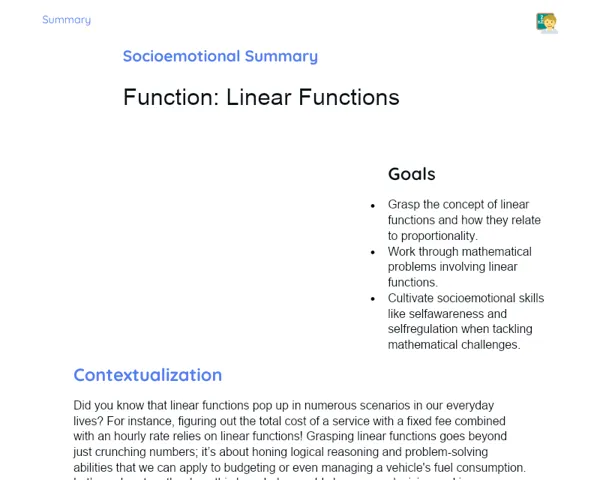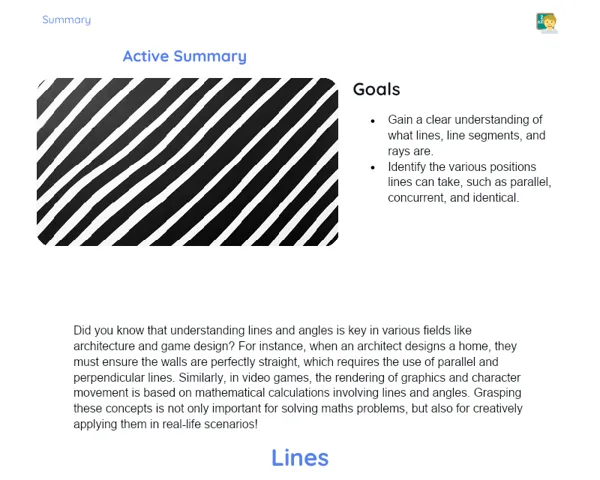Summary Tradisional | Modular Inequality
Contextualization
Modular inequalities are a key concept in mathematics that focus on absolute values. The absolute value of a number showcases its distance from zero along a number line, regardless of whether it's positive or negative. For instance, both 3 and -3 share the same absolute value of 3. This understanding is crucial for tackling inequalities dealing with absolute values, where the size of the number is what truly counts, not its sign.
These inequalities find application in various fields, such as physics, where calculating distances or magnitudes of forces is essential without regard for direction. They are also relevant in economics, aiding in the analysis of absolute changes in financial data. Moreover, modular inequalities play a vital role in civil engineering, for example, when calculating changes in material lengths due to temperature shifts, and they are used in computer graphics to calculate the distances between points in 3D space, ensuring high precision in rendered images.
To Remember!
Concept of Absolute Value
The absolute value, or modulus, of a number represents its distance from zero on a number line, irrespective of its sign. For example, both the number 3 and -3 share the same absolute value, which is 3. This trait of absolute value is crucial for solving modular inequalities, as we are primarily interested in the size of the number rather than its sign.
In mathematical terms, the absolute value of a number x is denoted as |x|, and defined as follows: if x is greater than or equal to zero, |x| = x; if x is less than zero, |x| = -x. This implies that the absolute value of any number is always a non-negative value.
The absolute value concept is prevalent in numerous areas of mathematics and other disciplines, such as physics and economics, owing to its capacity to simplify the analysis of scenarios where only the size matters. For example, when calculating the distance between two points on a number line, we apply the absolute value to ensure we focus solely on the distance, not the direction.
-
The absolute value indicates how far a number is from zero.
-
The absolute value is always a non-negative figure.
-
Expressed as |x|, where |x| = x if x ≥ 0, and |x| = -x if x < 0.
Definition of Modular Inequality
A modular inequality includes an expression within an absolute value and establishes a relationship of inequality. The most common forms of modular inequalities are |x| > a and |x| < a, where a is a positive real number. These inequalities help identify ranges of values that fulfill the condition, focusing solely on the numbers’ magnitudes.
To solve an inequality of the type |x| > a, we separate this into two: x > a or x < -a. We do this because we are concerned with the values of x that possess magnitudes greater than a, regardless of the sign. For example, for |x| > 2, the solution would state that x > 2 or x < -2.
Conversely, to resolve an inequality of the type |x| < a, we separate it into -a < x < a. In this instance, we are looking for the values of x whose magnitudes are less than a. For example, for |x| < 4, the conclusion would be -4 < x < 4. We express these solutions in intervals on the number line.
-
Modular inequalities involve inequalities with absolute values.
-
In the case of |x| > a, the solution is x > a or x < -a.
-
For |x| < a, the solution is -a < x < a.
Solving Inequalities of the Type |x| > a
To solve inequalities of the type |x| > a, we assess two scenarios: x > a and x < -a. This is because we are interested in those x values whose absolute sizes exceed a, irrespective of their signs. The solutions to these inequalities yield two distinct intervals on the number line.
For instance, consider the inequality |x| > 5. We separate this inequality into two: x > 5 or x < -5. Therefore, our solution indicates that values of x exist outside the interval [-5, 5]. Visually, this can be depicted on the number line as two intervals: (5, ∞) and (-∞, -5).
Understanding these inequalities is crucial in various practical applications, such as calculating tolerances in engineering, where it’s vital to ensure certain parameters stay outside specific limits for the safety and effectiveness of a project.
-
For |x| > a, we assess x > a and x < -a.
-
We identify two distinct intervals as solutions: (a, ∞) and (-∞, -a).
-
These inequalities are beneficial in practical applications such as tolerance calculations.
Solving Modular Inequalities with Linear Expressions
When a modular inequality involves linear expressions like |2x - 1| < 3x, the approach to resolving it demands careful consideration. Firstly, we split the inequality into two cases: 2x - 1 < 3x and 2x - 1 > -3x. We then solve each case independently to figure out the intervals of x that satisfy the inequality.
For the initial case, 2x - 1 < 3x, isolating x gives -1 < x, or x > -1. In the second case, isolating x from 2x - 1 > -3x leads to 5x > 1, resulting in x > 1/5. The culmination of these solutions provides us with the final interval for x.
Such inequalities are common when dealing with more complex issues, emerging in various domains like the analysis of dynamic systems, where understanding the intervals that sustain a system's stability is crucial. Solving these inequalities allows for a precise and thorough analysis of related problems.
-
Divide the inequality into two cases: 2x - 1 < 3x and 2x - 1 > -3x.
-
Independently solve each case to identify intervals for x.
-
Such inequalities arise in complex problem-solving and dynamic systems analysis.
Key Terms
-
Absolute Value: The distance of a number from zero on the number line, ignoring its sign.
-
Modular Inequality: An inequality that includes expressions enclosed within an absolute value.
-
Interval: A set of numbers that satisfy a given inequality.
-
Linear Expression: A mathematical representation of a straight line.
Important Conclusions
In today’s lesson, we delved into the concept of absolute value as the distance of a number from zero on the number line, irrespective of its sign, and how this is applied to solving modular inequalities. We reviewed the definition of modular inequalities and their standard forms, like |x| > a and |x| < a, detailing the solutions to these inequalities and emphasizing the significance of the value intervals that meet the specified conditions.
Moreover, we examined how to resolve more intricate modular inequalities involving linear expressions, such as |2x - 1| < 3x, demonstrating how to break down the inequality into cases and solve each one. This approach provided us with a more in-depth understanding of the techniques required to tackle problems involving absolute values in practical scenarios.
We underscored the relevance of modular inequalities by highlighting their applicability across various fields, including engineering, physics, and computer graphics. These mathematical tools are crucial for addressing problems where only the size of the values matters, contributing to accurate and detailed analyses in diverse areas of study.
Study Tips
-
Go over the examples worked on in class and practice solving related problems to reinforce your grasp of how to tackle modular inequalities.
-
Utilize supplementary resources such as textbooks and educational videos to discover various approaches and methods for solving modular inequalities, broadening your techniques.
-
Formulate study groups with classmates to collaboratively discuss and work through more elaborate problems, sharing insights and strategies to enhance the overall comprehension of the topic.



